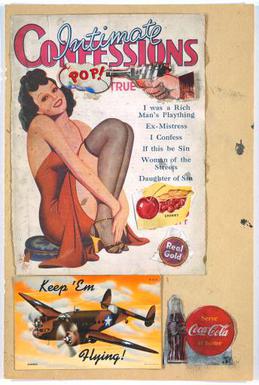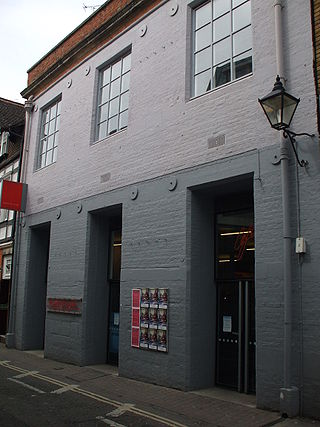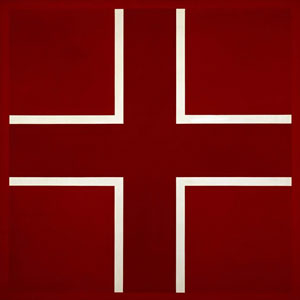
Roy Fox Lichtenstein was an American pop artist. During the 1960's, along with Andy Warhol, Jasper Johns, and James Rosenquist, he became a leading figure in the new art movement. His work defined the premise of pop art through parody. Inspired by the comic strip, Lichtenstein produced precise compositions that documented while they parodied, often in a tongue-in-cheek manner. His work was influenced by popular advertising and the comic book style. His artwork was considered to be "disruptive". Lichtenstein described pop art as "not 'American' painting but actually industrial painting". His paintings were exhibited at the Leo Castelli Gallery in New York City.

Pop art is an art movement that emerged in the United Kingdom and the United States during the mid- to late-1950s. The movement presented a challenge to traditions of fine art by including imagery from popular and mass culture, such as advertising, comic books and mundane mass-produced objects. One of its aims is to use images of popular culture in art, emphasizing the banal or kitschy elements of any culture, most often through the use of irony. It is also associated with the artists' use of mechanical means of reproduction or rendering techniques. In pop art, material is sometimes visually removed from its known context, isolated, or combined with unrelated material.

Elaine Frances Sturtevant, also known professionally as Sturtevant, was an American artist. She achieved recognition for her carefully inexact repetitions of other artists' works.

La Cienega Boulevard is a major north–south arterial road in the Los Angeles metropolitan area that runs from the Sunset Strip in West Hollywood in the north to El Segundo Boulevard in Hawthorne in the South. It was named for Rancho Las Cienegas, literally "The Ranch Of The Swamps," an area of marshland south of Rancho La Brea.

Modern Art Oxford is an art gallery established in 1965 in Oxford, England. From 1965 to 2002, it was called The Museum of Modern Art, Oxford.

Leo Castelli was an Italian-American art dealer who originated the contemporary art gallery system. His gallery showcased contemporary art for five decades. Among the movements which Castelli showed were Surrealism, Abstract Expressionism, Neo-Dada, Pop Art, Op Art, Color field painting, Hard-edge painting, Lyrical Abstraction, Minimal Art, Conceptual Art, and Neo-expressionism.

The Gagosian Gallery is a modern and contemporary art gallery owned and directed by Larry Gagosian. The gallery exhibits some of the most well-known artists of the 20th and 21st centuries. As of 2024, Gagosian employs 300 people at 19 exhibition spaces – including New York City, London, Paris, Basel, Beverly Hills, San Francisco, Rome, Athens, Geneva, and Hong Kong – designed by architects such as Caruso St John, Richard Gluckman, Richard Meier, Jean Nouvel, and Annabelle Selldorf.

Lawrence Gilbert "Larry" Gagosian is an Armenian American art dealer who owns the Gagosian Gallery chain of art galleries. Working in concert with collectors including Douglas S. Cramer, Eli Broad, and Keith Barish, he developed a reputation for staging museum-quality exhibitions of contemporary art.

John Harvey McCracken was an American minimalist visual artist. He lived and worked in Los Angeles, Santa Fe, New Mexico, and New York.
Ileana Sonnabend was a Romanian-American art dealer of 20th-century art. The Sonnabend Gallery opened in Paris in 1962 and was instrumental in making American art of the 1960s known in Europe, with an emphasis on American pop art. In 1970, Sonnabend Gallery opened in New York on Madison Avenue, and in 1971 relocated to 420 West Broadway in SoHo where it was one of the major protagonists that made SoHo the international art center it remained until the early 1990s. The gallery was instrumental in making European art of the 1970s known in America, with an emphasis on European conceptual art and Arte Povera. It also presented American conceptual and minimal art of the 1970s. In 1986, the so-called "Neo-Geo" show introduced, among others, the artist Jeff Koons. In the late 1990s, the gallery moved to Chelsea and continues to be active after Sonnabend's death. The gallery goes on showing the work of artists who rose to prominence in the 1960s and 1970s including Robert Morris, Bernd and Hilla Becher and Gilbert & George as well as more recent artists including Jeff Koons, Rona Pondick, Candida Höfer, Elger Esser, and Clifford Ross.
Dan Christensen was an American abstract painter He is best known for paintings that relate to Lyrical Abstraction, Color field painting, and Abstract expressionism.
Walter "Chico" Hopps was an American museum director, gallerist, and curator of contemporary art. Hopps helped bring Los Angeles post-war artists to prominence during the 1960s, and later went on to redefine practices of curatorial installation internationally. He is known for contributing decisively to “the emergence of the museum as a place to show new art.”
Giuseppe Panza di Biumo was a collector of modern art. He lived in Milan and Varese, Italy.
Virginia Dwan was an American art collector, art patron, philanthropist, and founder of the Dwan Light Sanctuary in Montezuma, New Mexico. She was the former owner and executive director of Dwan Gallery, Los Angeles (1959–1967) and Dwan Gallery New York (1965–1971), a contemporary art gallery closely identified with the American movements of minimalism, conceptualism, and land art.

Look Mickey is a 1961 oil on canvas painting by Roy Lichtenstein. Widely regarded as the bridge between his abstract expressionism and pop art works, it is notable for its ironic humor and aesthetic value as well as being the first example of the artist's employment of Ben-Day dots, speech balloons and comic imagery as a source for a painting. The painting was bequeathed to the Washington, D.C., National Gallery of Art upon Lichtenstein's death.

The Broad is a contemporary art museum on Grand Avenue in Downtown Los Angeles. The museum is named for philanthropists Eli and Edythe Broad, who financed the $140 million building that houses the Broad art collections. It offers free general admission to its permanent collection galleries. However, not all of its events are free and admission prices may vary by exhibit and/or by event. It opened on September 20, 2015.
Orpha Mae Klinker was an American artist well known for her California plein air landscape paintings and etchings as well as her portraiture and early California historic sites. She was also an active illustrator and graphic designer. Klinker was recognized for her series of historical and pioneer paintings. She painted a series of portraits of notable Californians and memorialized many historic early California structures on canvas. On October 14, 1963, she was awarded a resolution by the City Council of Los Angeles, recognizing her outstanding professional skill and appreciation for the many honors she has brought to the city. The commendatory scroll praised Klinker for her role as an oil painter and mentioned many of her portrait subjects such as General John C. Frémont, Andrés Pico, José Antonio Carrillo and Dr. Joseph P. Widney.
Jeff Colson is an American artist.

Michael Maloney is a Los Angeles-based art appraiser and art dealer. He owned and operated the Michael Maloney Gallery in Santa Monica, California (1985–90) and Maloney Fine Art in Culver City, California (2006–16), and since 1998 has pursued a career as an art appraiser and private dealer in Los Angeles and New York.
Laddie John Dill is an American artist. Dill calls his work "light sentences". Dill received a BFA degree from Chouinard Art Institute, Los Angeles, in 1968. He is the older brother of sculptor Guy Dill.













